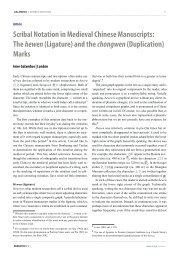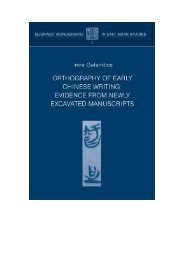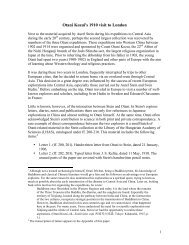Japanese 'Spies' along the Silk Road - Chinese manuscripts
Japanese 'Spies' along the Silk Road - Chinese manuscripts
Japanese 'Spies' along the Silk Road - Chinese manuscripts
Create successful ePaper yourself
Turn your PDF publications into a flip-book with our unique Google optimized e-Paper software.
36 <strong>Japanese</strong> Religions 35 (1 & 2)<br />
official agency has never been so smudged as in <strong>the</strong> case of Central Asia. Some of<br />
<strong>the</strong> most successful explorers admittedly, sometimes of course only in retrospect,<br />
conducted military intelligence missions disguised as scientific exploration.<br />
Among <strong>the</strong> first of such visitors was Chokan Valikhanov (1835-1865), a<br />
Kazakh officer in <strong>the</strong> Russian army who traveled in 1858-1859 to Kashgar in<br />
disguise of a local merchant. Beside his military mission, he also ga<strong>the</strong>red a wealth<br />
of ethnographical information and published <strong>the</strong>se in a succession of books and<br />
articles. 3 Even more important were <strong>the</strong> expeditions of Nikolai M. Przhevalsky<br />
(1839-1888) who traveled in full military attire with a regiment of cossacks and<br />
even fought against native tribes whenever he considered it necessary. 4 Although he<br />
never achieved his life-long aspiration of reaching Lhasa, he became canonized in<br />
Russia as <strong>the</strong> quintessentual “scientific explorer,” with books about his achievements<br />
filling <strong>the</strong> shelves of Russian libraries. Yet ano<strong>the</strong>r famous explorer working for<br />
<strong>the</strong> General Staff of <strong>the</strong> Russian Empire was Carl Gustaf Mannerheim (1867-<br />
1951), a Finnish baron who led an expedition from Tashkent to Kashgar, partly<br />
accompanying <strong>the</strong> French Sinologist Paul Pelliot (1878-1945). Traveling on<br />
a military intelligence mission, he utilized his Scandinavian background and<br />
disguised himself as a Swedish scientist. In later years, he went on to a spectacular<br />
career, having served as Regent, Marshal, and eventually President of Finland.<br />
On <strong>the</strong> British side, Sir Francis E. Younghusband’s (1863-1942) journeys<br />
from 1887 in Central Asia are representative of semi-military travels. Although<br />
he visited <strong>the</strong> region as an officer on leave from his regiment, he also published an<br />
account of his trip (Younghusband 1896) and was consequently elected as member<br />
of <strong>the</strong> Royal Geographical Society. Once a British representative was stationed<br />
in Kashgar, <strong>the</strong> Indian Government encouraged its officers to go on hunting trips<br />
in <strong>the</strong> region, as a means of both establishing presence and ga<strong>the</strong>ring intelligence.<br />
These officers who spent <strong>the</strong>ir leave hunting in <strong>the</strong> Pamirs or Western Tibet would<br />
fit nei<strong>the</strong>r <strong>the</strong> category of spies nor that of explorers, yet <strong>the</strong>y were an important<br />
part of <strong>the</strong> Indian Government’s general strategy to increase influence in Western<br />
China.<br />
3. Valikhanov’s collected writings have been published in 1961 by <strong>the</strong> Academy of<br />
Sciences of his native Kazakhstan (Valikhanov 1961). In English, a small selection<br />
of his work had come out in a collection titled The Russians in Central Asia in 1865<br />
(Valikhanof et al. 1865).<br />
4. Przhevalsky’s main books were translated into English shortly after <strong>the</strong>ir appearance<br />
in Russia. Thus both his Mongolia, <strong>the</strong> Tangut Country and <strong>the</strong> Solitudes of Nor<strong>the</strong>rn<br />
Tibet (Prejevalsky 1876) and his From Kulja, across <strong>the</strong> Tian Shan to Lob-Nor<br />
(Prejevalsky 1879) were well known in England in <strong>the</strong> second half of <strong>the</strong> 19th century.







